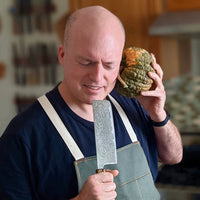
A Quick Guide To Knife Steel for Non-Nerds
This guide is designed to help you pick the right knife, without needing to know everything about steel. I grew up in the ’80s and ’90s when being a nerd was not synonymous with being cool. That, coupled with the fact I’m a cook and knife user, not a steel analyzer or a fancy book-learner qualifies me to write the simple guide to steel, focusing on the functions that regularly affect the user.
The top 3 questions to ask when choosing a knife are:
- Does it rust?
- How long does it stay sharp for?
- Does it chip easily?
The short version
If tarnish and water spots are dirty and upset you, don’t get a 'carbon steel' knife. They will discolour and can rust if you're not careful, so they're more work to maintain. The knives we sell are all really really sharp — but the carbon steel ones are sometimes sharper. Take care of any good knife and it will hold its edge for a very long time. Some have a carbon steel core but have a layer of stainless on the outside, leaving only the non-stainless edge to deal with.
The Long Version
A long time ago they made steel. It was sharp and it rusted. Then, just over 100 years ago, they made stainless steel which wasn’t as sharp but didn’t rust. Then recently, they made powdered stainless steel that is crazy sharp and doesn’t rust. The most recent innovation of powder metallurgy allows for stainless steel that can get just as sharp as high-carbon steel and keep an edge just as long, without rusting.

Rust
Because rusting is in steel’s nature, it will oxidize slowly no matter how well you care for it. This means it’s going to oxidize and turn grey when you first use it, and the finish will change. You just can’t get around that. If you let water or vegetable juices stay on the steel, it will rust. The orange kind of rust is bad and you want to remove it as soon as you see it. You can learn more about carbon steel care here, but essentially grey is good, orange is bad.
Why doesn’t stainless steel rust? Because of science. Keep in mind, it’s called stain-less not stain-never. This is a different kind stainless steel than regular cutlery, so no dishwasher, ever. The Japanese knives that we import are made from stainless steel that is really sharp and better at holding an edge than European or mass-market knives, but many stainless knives don't get quite as sharp or stay sharp as long as carbon steel knives. Most of the Japanese knives we carry are made of 2 outer layers of soft steel, that cover a hard core steel (which is what the edge is made from). There are some that are a combination: stainless steel on the outside and carbon steel on the inside. This gives you great edge performance, with only 5% of the exposed surface area susceptible to rust.
Sharpness and BrittlenessThe steel in a Japanese knife is harder, so it stays sharper for longer and can hold a much sharper edge than knives from Costco, Ikea, etc. This comes with a trade-off: it can chip, because harder materials are more brittle. Sharpness and brittleness go hand-in-hand. Any high-performance knife shouldn’t be used for bones or frozen foods, but rather food you could chew with your own teeth. Think meat, fish and vegetables. In general, regular stainless steel is less prone to chipping than carbon steel but harder powdered stainless is a little more sensitive than other stainless steels. If you take care of your tools, they will last longer. The same goes for your knife’s edge. Avoid using your knives as a hammer, or cutting on hard surfaces like your granite countertop.
Choosing the Right Knife SteelIf you aren’t bothered by tarnish and are willing to wipe off your knife when you use it, then go for carbon steel. Not being uptight about your knife being shiny means you can have a knife that will be incredible at holding its edge, and will take on a unique look as you use it. Think of how your favourite pair of jeans or boots develop a unique look after you've broken them in. If you want exceptional sharpness and no rust, look to the powdered steel types. If you just want a very sharp knife that dependably cuts your food without any hassle, go for the regular stainless steel.
|
Steel Types and Names |
||
|
Stainless |
Carbon |
Powdered stainless |
|
Yellow |
||
|
Molybdenum Vanadium |
||
|
Stainless-Clad Carbon-Core Knife Lines |
||
|
White Steel core |
Blue Steel core |
Super Blue core |
This chart shows the level of edge retention, the rustiness and the brittleness (represented by the size of the bubble). I hope it helps the visual folks out there

I hope this helps you get comfortable with the different steel types, their strengths and their weaknesses. If you feel like you want to go deeper down the rabbit hole, check out our book The Knifenerd Guide to Japanese Knives or read our blog Knife Knowledge Basics: Knife Steel. If you still feel like you need help picking a knife, contacts us and we'll be happy to guide you through the process!





